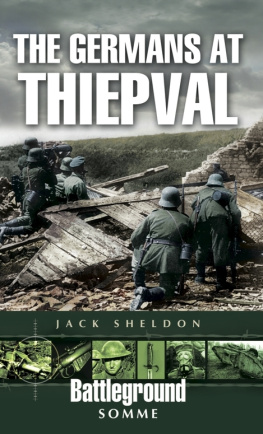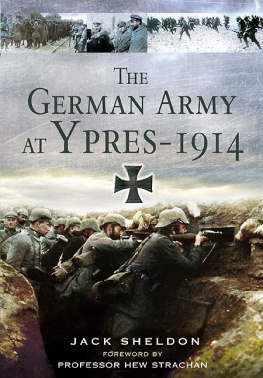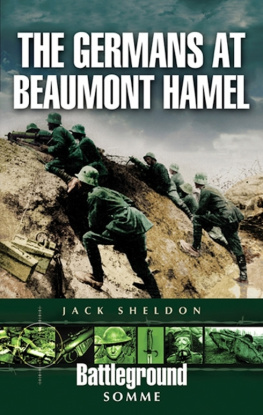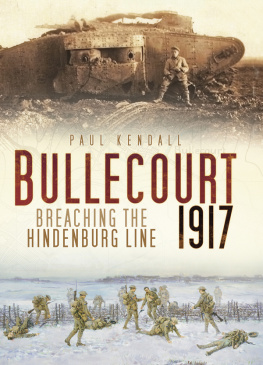Respectfully dedicated by gracious permission to
HRH The Duke of Kent KG
who at Sandhurst, many years ago,
guided my first footsteps as a soldier.
By the same author:
The German Army on the Somme 1914 1916
The German Army at Passchendaele
The German Army on Vimy Ridge 1914-1917
The German Army at Cambrai
The German Army at Ypres 1914
The German Army on the Western Front 1915
The Germans at Beaumont Hamel
The Germans at Thiepval
With Nigel Cave:
The Battle for Vimy Ridge 1917
Le Cateau
Ypres 1914: Langemarck
Ypres 1914: Messines
Ypres 1914: Menin Road
First published in Great Britain in 2015
PEN AND SWORD MILITARY
An imprint of
Pen & Sword Books Ltd
47 Church Street
Barnsley
South Yorkshire, S70 2AS
Copyright Jack Sheldon, 2015
ISBN: 978 1 78346 345 9
PDF ISBN: 978 1 47387 287 5
EPUB ISBN: 978 1 47387 286 8
PRC ISBN: 978 1 47387 285 1
The right of Jack Sheldon to be identified as Author of this work has been asserted by him in accordance with the Copyright, Designs and Patents Act 1988.
A CIP catalogue record for this book is available from the British Library.
All rights reserved. No part of this book may be reproduced or transmitted in any form or by any means, electronic or mechanical including photocopying, recording or by any information storage and retrieval system, without permission from the Publisher in writing.
Printed and bound in England by
CPI Group (UK) Ltd, Croydon, CR0 4YY
Typeset in Times by CHIC GRAPHICS
Pen & Sword Books Ltd incorporates the imprints of Aviation, Atlas, Family History, Fiction, Maritime, Military, Discovery, Politics, History, Archaeology, Select, Wharncliffe Local History, Wharncliffe True Crime, Military Classics, Wharncliffe Transport, Leo Cooper, The Praetorian Press, Remember When, Seaforth Publishing and Frontline Publishing.
For a complete list of Pen & Sword titles please contact
PEN & SWORD BOOKS LIMITED
47 Church Street, Barnsley, South Yorkshire, S70 2AS, England
E-mail:
Website: www.pen-and-sword.co.uk
Contents
Introduction
A t the turn of the year 1916/17, the Allies had good reason to be confident about the future course of the war. They had inflicted huge casualties on the German army at Verdun and on the Somme; and although their own losses had been heavy and they had come nowhere near to breaking the German army, nevertheless, their greater manpower reserves meant that it was far easier for them than for the Central Powers to replenish worn down formations and create new ones. On the industrial front, despite the fact that the Hindenburg Plan (which was also making great demands on German male manpower) was beginning to get into its stride, the Allies were also pulling ahead in the battle to produce larger and larger quantities of guns, aircraft and munitions. None of the Allied leaders or military commanders was under any illusion about the size and complexity of the task which lay before them, but they were unanimous in their agreement forged at Chantilly in November 1916 to launch a major combined offensive aimed at the shoulders of the giant German salient between the Somme and the Oise. This was intended to be mounted in irresistible force, to break through the German defences swiftly and to eject that army from all the territory it had captured in the west.
For the Germans it was a time of intensive operational analysis and a switch of emphasis towards the Western Front. The situation in the east was still far from decided, but it was clear that the intensity of campaigning had slackened, so that the necessity to maintain co-located headquarters with the Austro-Hungarian high command was less pressing. Kaiser Karl moved his headquarters to Baden bei Wien, between Vienna and Wiener Neustadt, whilst the Germans, retaining the possibility of using Ple at some future date, physically moved westwards, so as to be nearer the main threat. It was assessed that further attacks were likely in all theatres of operations, including the Isonzo front in Italy, and that the Allies enjoyed a superiority in manpower and materiel of at least sixty percent overall. Importantly, the British, who up until then had lagged well behind the French in heavy artillery, had increased the numbers available at the front from 761 in July 1916 to 1,157 by the turn of the year and would have nearer to 1,500 heavy guns and howitzers available by the end of March 1917. Impressive though this increase was and hard the pounding of the German troops around Arras in early April would be, the French army still had a great many more - some 5,000, which made it possible to allocate an average of approximately forty to every divisional front and a great many more where they were concentrated opposite potential breakthrough points.
At the start of 1917 it was still difficult for German intelligence staffs to be certain where the blows would fall, though every effort was made to collate agents reports and to monitor railway usage and placement of reserves in order to pick up early indications. There was also increasing concern that the very layout of the German front line almost invited attack that the sheer size of the salient to be defended would stretch manpower to the limit and beyond. These considerations were what drove the decision, taken at Cambrai on 5 September 1916, to begin the construction of massive new defensive lines to the rear. Even though at that time there was no immediate pressing need to move to such positions, the very fact of their planned construction along the lines Arras - St Quentin - La Fre - Cond, near Soissons (Siegfriedstellung = Hindenburg Line) and Pont Mousson - Verdun (Michelstellung), together with lesser works along other stretches of the front, indicated that sooner or later they would have to be occupied. Priority went to the Siegfriedstellung so, while the autumn battles continued to rage along the Western Front, work directed by Army Group Crown Prince Rupprecht went ahead from October that year at high speed on a truly colossal building site, which stretched for over 140 kilometres and absorbed the labour of a 65,000 man workforce and immense quantities of raw materials.
It seems clear that at the turn of the year, OHL [Supreme Army Headquarters] still hoped to be able to carry out some offensive of its own and thus avoid adopting a policy of strategic defence in 1917, but staff studies soon indicated that even if four more divisions could be transported west from the Eastern Front, by March 1917 only a total of seventeen divisions could be made available. That effectively ruled out any sort of significant German attack and, as evidence of Allied intentions continued to mount, there was additional concern that with a total of only 129 divisions in the west to counter the 168 at the disposal of the Allies - and those somewhat weaker in manpower - the only feasible solution was to go on the defensive and hope to hold until the recently launched unrestricted submarine warfare, together with the increased production of war materiel under the Hindenburg Plan, began to bear fruit.
Other reasons were adduced at the time to justify the withdrawal, which involved voluntarily yielding more ground than had ever been captured up that point in the war: a carefully timed move would disrupt Allied plans; the forward positions on the Somme were in an appalling state and there would be little or no possibility of improving them before the Allied offensive broke; it would be easier to extract valuable equipment and stores if this was done without enemy pressure; and a scorched earth policy would make it hard for the Allies to close up rapidly on the new German positions. Naturally, there was some truth in all of this, though the deliberate wrecking of the Somme rear areas came close to bringing Crown Prince Rupprecht to the point of resignation, so disgusted was he at what was planned. All that aside, ultimately it was manpower, the overall lack of it and the need to shorten the line in order to thicken up forward defences and create operational reserves, that finally led to the implementation of










